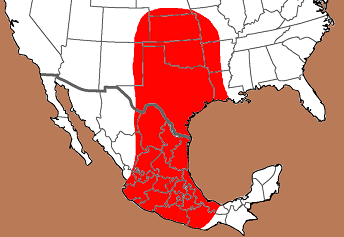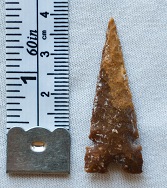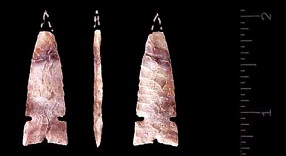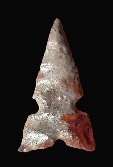Outline is Representative of Size and Shape:

Name Details:
Identified By: Alex Krieger (described) / Dee Ann Suhm, Alex Krieger, and Edward Jelks (named)
Named For: Type Site
Date Identified: 1946 (described) / 1954 (named)
Type Site: The Harrell Site, Young County, Texas
Identified By: Alex Krieger (described) / Dee Ann Suhm, Alex Krieger, and Edward Jelks (named)
Named For: Type Site
Date Identified: 1946 (described) / 1954 (named)
Type Site: The Harrell Site, Young County, Texas
Point Validity:
Valid type
Suhm was an eminent Texas anthropologist who, among many distinguished positions, served as Director of Texas Archaeological Research Laboratory. Krieger was a renowned anthropologist who spent most of his career in Texas cataloging projectile points and pottery in Texas before moving on to the University of Washington. Jelks was a distinguished anthropologist and helped organize the newly formed Department of Anthropology at Illinois State University where he was a Professor. His work in Texas furthered the understanding of Texas archeology and was a founding force for the Society of Historical Archeology. This type was named in a professional publication and subsequent book and has many professional references. This is a valid type.
Suhm was an eminent Texas anthropologist who, among many distinguished positions, served as Director of Texas Archaeological Research Laboratory. Krieger was a renowned anthropologist who spent most of his career in Texas cataloging projectile points and pottery in Texas before moving on to the University of Washington. Jelks was a distinguished anthropologist and helped organize the newly formed Department of Anthropology at Illinois State University where he was a Professor. His work in Texas furthered the understanding of Texas archeology and was a founding force for the Society of Historical Archeology. This type was named in a professional publication and subsequent book and has many professional references. This is a valid type.
Harrell Tri-Notch
Cluster: Washita Cluster Description of Physical Characteristics and Flaking Pattern:
This is a thin small to point with a flattened cross section. The blade is primarily straight and may be serrated. This point has parallel notches with horizontal shoulders with an expanded stem. The ears are commonly pointed or with sharp corners. The base has a center notch. This point has a random flaking pattern.
Size Measurements:
Total Length - 13 to 35 mm (average 24 mm), Stem Length - 8 to 11 mm, Width at Shoulders - 8 to 15, Neck Width - 5 to 10 mm, Notch Width - .5 to 5 mm (average 2 mm), Notch Depth - 2 to 3 mm, Notch Placement - 1/4 to 1/2 from the base (based on total length), Basal Width - 12 to 20 mm (Suhm and Krieger, 1954, MacNiesh 1967).
Total Length - 13 to 35 mm (average 24 mm), Stem Length - 8 to 11 mm, Width at Shoulders - 8 to 15, Neck Width - 5 to 10 mm, Notch Width - .5 to 5 mm (average 2 mm), Notch Depth - 2 to 3 mm, Notch Placement - 1/4 to 1/2 from the base (based on total length), Basal Width - 12 to 20 mm (Suhm and Krieger, 1954, MacNiesh 1967).
Commonly Utilized Material:
Additional Comments:
The points in this cluster are similar to the points in the Woodland/Mississippian triangular cluster, except these points have side notches (Morrow, 1984). Both types of points are noted for being thin and in the shape of an isosceles or equilateral triangle. Points in this cluster are noted for a single or multiple parallel notches in the blade. The blade may be serrated for points in this cluster (W2).
Bell (1958) suggest that the name Harrell be applied to points with a center basal notch while the name Washita be applied to points lacking the center notch.
The points in this cluster are similar to the points in the Woodland/Mississippian triangular cluster, except these points have side notches (Morrow, 1984). Both types of points are noted for being thin and in the shape of an isosceles or equilateral triangle. Points in this cluster are noted for a single or multiple parallel notches in the blade. The blade may be serrated for points in this cluster (W2).
Bell (1958) suggest that the name Harrell be applied to points with a center basal notch while the name Washita be applied to points lacking the center notch.
Distribution:

Distribution Comments:
This point are primarily associated with the Caddoan culture and subcultures of Texas, Oklahoma, and into Kansas, Missouri, Arkansas, and Louisiana and into Mexico. These point may be found into adjacent regions with decreased frequency. Points outside the Caddoan cultural territory may fall into one of the Plains Side Notch types. Points found into the Pueblo Cultural and sub culture territories may fall into the Pueblo Side Notch type. MacNeish reports this type into the Valley of Mexico, Tehuacan Valley, Oaxaca, and Puebla. Reported at Cueva de la Nopalera,
This point are primarily associated with the Caddoan culture and subcultures of Texas, Oklahoma, and into Kansas, Missouri, Arkansas, and Louisiana and into Mexico. These point may be found into adjacent regions with decreased frequency. Points outside the Caddoan cultural territory may fall into one of the Plains Side Notch types. Points found into the Pueblo Cultural and sub culture territories may fall into the Pueblo Side Notch type. MacNeish reports this type into the Valley of Mexico, Tehuacan Valley, Oaxaca, and Puebla. Reported at Cueva de la Nopalera,
Age / Periods:
Date: 900 - 500 B.P.
Cultural Period: Mississippian
Glacial Period: Modern Times
Culture: Caddoan Culture
Date: 900 - 500 B.P.
Cultural Period: Mississippian
Glacial Period: Modern Times
Culture: Caddoan Culture
Age Details:
Suhm et al. (1954), feel that the Harrell type is a major type of the Antelope Focus, and one of several types in the Henrietta and Wylie foci. At Cueva de la Nopalera these points were reported in level 3 with primary usage in level 2.
Suhm et al. (1954), feel that the Harrell type is a major type of the Antelope Focus, and one of several types in the Henrietta and Wylie foci. At Cueva de la Nopalera these points were reported in level 3 with primary usage in level 2.
Similar Points:
Cahokia, Desert, Huffaker, Little Sioux, Plains, Prairie, Teotihuacan, Toyah, Washita
Cahokia, Desert, Huffaker, Little Sioux, Plains, Prairie, Teotihuacan, Toyah, Washita
Other points in this cluster / Related / Associated Points:
Cahokia, Des Moines, Haskell, Huffaker, Reed, Washita, Washita Peno
Cahokia, Des Moines, Haskell, Huffaker, Reed, Washita, Washita Peno










